Balbharti Maharashtra State Board 12th Biology Important Questions Chapter 3 Inheritance and Variation Important Questions and Answers.
Maharashtra State Board 12th Biology Important Questions Chapter 3 Inheritance and Variation
Multiple Choice Questions
Question 1.
Which one of the following characters is recessive in the case of the pea plants?
(a) Axial flower
(b) Green pod
(c) Green seed
(d) Inflated pod
Answer:
(c) Green seed
Question 2.
Which of the following trait is dominant in Pisum sativum?
(a) White flowers
(b) Green seeds
(c) Yellow pods
(d) Inflated pods
Answer:
(d) Inflated pods
![]()
Question 3.
When phenotypic and genotypic ratio is the same, then it is an example of ……………….
(a) incomplete dominance
(b) cytoplasmic inheritance
(c) quantitative inheritance
(d) incomplete dominance and co-dominance
Answer:
(a) incomplete dominance
Question 4.
A pea plant with yellow and round seeds is crossed with another pea plant with green and wrinkled seeds produce 51 yellow round seeds and 49 yellow wrinkled seeds, the genotype of plant with yellow round seeds must be ……………….
(a) YYRr
(b) YyRr
(c) YyRR
(d) YYRR
Answer:
(a) YYRr
Question 5.
When a single gene produces two effects and one of it is lethal, then the ratio is ……………….
(a) 2 : 1
(b) 1 : 1
(c) 1 : 2 : 1
(d) 1 : 1 : 1 : 1
Answer:
(a) 2 : 1
Question 6.
When two genes control a single character and have cumulative effect, the ratio is ……………….
(a) 1 : 1 : 1 : 1
(b) 1 : 4 : 6 : 4 : 1
(c) 1 : 2 : 1
(d) 1 : 6 : 15 : 20 : 15 : 6 : 1
Answer:
(d) 1 : 6 : 15 : 20 : 15 : 6 : 1
Question 7.
Genes located on the same locus but show more than two different phenotypes are called ……………….
(a) polygenes
(b) multiple alleles
(c) co-dominants
(d) pleiotropic genes
Answer:
(b) multiple alleles
Question 8.
Genotype refers to the genetic composition of ……………….
(a) an organism
(b) an organ
(c) chromosomes
(d) germ cells
Answer:
(a) an organism
Question 9.
Individuals having identical alleles of a gene are known as ……………….
(a) homozygous
(b) heterozygous
(c) hybrids
(d) dominants
Answer:
(a) homozygous
Question 10.
If a heterozygous tall plant is crossed with a homozygous dwarf plant, the proportion of dwarf progeny will be ……………….
(a) 100 per cent
(b) 75 per cent
(c) 50 per cent
(d) 25 per cent
Answer:
(c) 50 percent
Question 11.
Inheritance of AB blood group is due to ……………….
(a) incomplete dominance
(b) polyploidy
(c) polygeny
(d) co-dominance
Answer:
(d) co-dominance
Question 12.
The recombination of characters in a dihybrid cross is related to ……………….
(a) law of dominance
(b) incomplete dominance
(c) co-dominance
(d) independent assortment
Answer:
(d) independent assortment
Question 13.
Which one of the following is a true pleiotropic gene?
(a) HbA
(b) Hbs
(c) HbD
(d) HbP
Answer:
(b) Hbs
Question 14.
For demonstrating the law of independent assortment, one should carry out ……………….
(a) back cross
(b) test cross
(c) dihybrid cross
(d) monohybrid cross
Answer:
(c) dihybrid cross
Question 15.
Which one of the following is an example of multiple alleles?
(a) Height in pea plant
(b) Hair colour in cattle
(c) Petal colour in four o’clock plant
(d) Wing-size in Drosophila
Answer:
(d) Wing-size in Drosophila
Question 16.
For the formation of 50 seeds, how many minimum meiotic divisions are necessary?
(a) 25
(b) 50
(c) 75
(d) 63
Answer:
(d) 63
Question 17.
A cross used to verify the unknown genotype of F1 hybrid is a ………………. cross.
(a) test
(b) back
(c) dihybrid
(d) monohybrid
Answer:
(a) test
Question 18.
Appearance of new combinations in F2 generation in a dihybrid cross proves the law of ……………….
(a) dominance
(b) segregation
(c) independent assortment
(d) purity of gametes
Answer:
(c) independent assortment
Question 19.
Genotype of human blood group ‘O’ will be ……………….
(a) IAIA
(b) IAIB
(c) ii
(d) IAi
Answer:
(c) ii
Question 20.
The genotype of human blood group B is ……………….
(a) IAIA
(b) IBi
(c) IAIB
(d) ii
Answer:
(b) IBi
Question 21.
……………… chromosome appears ‘V’-shaped during anaphase.
(a) Metacentric
(b) Acrocentric
(c) Telocentric
(d) Sub-Metacentric
Answer:
(a) Metacentric
Question 22.
The sister chromatids are held together by ……………….
(a) centrioles
(b) chromonemata
(c) chromomere
(d) centromere
Answer:
(d) centromere
Question 23.
Which of the following is not X-linked disorder ?
(a) Haemophilia
(b) Night-blindness
(c) Hypertrichosis
(d) Myopia
Answer:
(c) Hypertrichosis
Question 24.
Which of the following is also called bleeder’s disease ?
(a) Anaemia
(b) Thrombocytopenia
(c) Polycythemia
(d) Haemophilia
Answer:
(d) Haemophilia
Question 25.
The person with Turner’s syndrome has ……………….
(a) 45 autosomes and X sex chromosome
(b) 44 autosomes and XYY sex chromosome
(c) 45 autosomes and Y chromosome
(d) 44 autosomes and X chromosome
Answer:
(d) 44 autosomes and X chromosome
Question 26.
Which of the following is sex chromosomal disorder ?
(a) Colour blindness
(b) Turner’s syndrome
(c) Thalassemia
(d) Down’s syndrome
Answer:
(b) Turner’s syndrome
Question 27.
The word chroma means ……………….
(a) a part of nucleus
(b) a part of chromosome
(c) colour
(d) filamentous body
Answer:
(c) colour
Question 28.
Presence of whole sets of chromosomes is called ……………….
(a) aneuploidy
(b) euploidy
(c) ploidy
(d) chromatography
Answer:
(b) euploidy
Question 29.
The synonymous term for centromere is ……………….
(a) primary constriction
(b) secondary constriction
(c) telomere
(d) satellite
Answer:
(a) primary constriction
Question 30.
Small swellings on the surface of the chromosome are called ……………….
(a) centromeres
(b) chromonemata
(c) chromomeres
(d) telomeres
Answer:
(c) chromomeres
Question 31.
On what basis are the chromosomes usually classified?
(a) On the basis of their function
(b) On the basis of their length
(c) On the basis of the position of the centromere
(d) On the basis of their number
Answer:
(c) On the basis of the position of the centromere
Question 32.
Find the mismatched pair :
(a) Metacentric – V-shaped
(b) Sub-Metacentric – L-shaped
(c) Acrocentric – J-shaped
(d) Telocentric – S-shaped
Answer:
(d) Telocentric – S-shaped
Question 33.
Out of the following combinations which individual will have maximum genetically active DNA?
(a) 44 + XX
(b) 44 + XY
(c) 44 + XYY
(d) Down’s syndrome
Answer:
(a) 44 +XX
![]()
Question 34.
Crossing over occurs at the time of ……………….
(a) diplotene
(b) pachytene
(c) leptotene
(d) zygotene
Answer:
(b) pachytene
Question 35.
A mature woman has ………………. linkage groups.
(a) 44
(b) 22
(c) 46
(d) 23
Answer:
(d) 23
Question 36.
The pairing of homologous chromosomes is called ……………….
(a) crossing over
(b) terminalisation
(c) synapsis
(d) bivalent
Answer:
(c) synapsis
Question 37.
If only one ‘X’ chromosome is found in a female person, which of the following symptoms will she show?
(a) epicanthal skin fold
(b) webbing of neck
(c) small testis and absence of spermatogenesis
(d) presence of simian crease on the palm
Answer:
(b) webbing of neck
Question 38.
If centromere is situated in the middle of the chromosome, it is called ……………….
(a) metacentric
(b) acrocentric
(c) submetacentric
(d) telocentric
Answer:
(a) metacentric
Question 39.
In which of the following disorders the number of chromosomes present is (extra) 47?
(a) Turner’s syndrome
(b) Cushing’s syndrome
(c) Acquired immuno-deficiency syndrome
(d) Down’s syndrome
Answer:
(d) Down’s syndrome
Question 40.
Myopia is an example of ……………….
(a) complete sex linkage
(b) incomplete sex linkage
(c) recombination
(d) crossing over
Answer:
(a) complete sex linkage
Question 41.
Down’s syndrome is represented by ……………….
(a) n + 1
(b) 2n + 1
(c) 3n + 1
(d) n – 1
Answer:
(b) 2n + 1
Classify the following to form Column B as per the category given in Column A
Question 1.
Types of traits:
[Sickle-cell anaemia, Flower colour of Mirabelis jalapa, Coat colour of cattle, Human blood groups, Widow’s peak, Height in human beings.]
| Column A | Column B |
| (1) Co-dominance | —————– |
| (2) Incomplete dominance | —————– |
| (3) Multiple allelism | —————- |
| (4) Pleiotropy | —————– |
| (5) Polygenes | —————- |
| (6) Autosomal dominance | —————— |
Answer:
| Column A | Column B |
| (1) Co-dominance | Coat colour of cattle |
| (2) Incomplete dominance | Flower colour of Mirabelis jalapa |
| (3) Multiple allelism | Human blood groups |
| (4) Pleiotropy | Sickle-cell anaemia |
| (5) Polygenes | Height in human beings |
| (6) Autosomal dominance | Widow’s peak |
Question 2.
Types of sex-linked genes:
[Haemophilia, Ichthyosis, Nephritis, Myopia, Hypertrichosis, Retinitis pigmentosa]
| Column A | Column B |
| (1) Completely X-linked genes | —————– |
| (2) Completely Y-linked genes | —————– |
| (3) Incompletely sex-linked genes | —————- |
Answer:
| Column A | Column B |
| (1) Completely X-linked genes | Haemophilia, Myopia |
| (2) Completely Y-linked genes | Ichthyosis,Hypertrichosis |
| (3) Incompletely sex-linked genes | Nephritis, Retinitis pigmentosa |
Question 3.
Genetic Disorders
[Turner’s syndrome, Sickle-cell anaemia, Thalassemia, Edward’s syndrome, Klinefelter’s syndrome, Down’s syndrome]
| Column A | Column B |
| (A) Autosomal disorder | —————– |
| (B) Sex chromosomal disorder | —————– |
| (C) Mendelian disorder | —————- |
Answer:
| Column A | Column B |
| (A) Autosomal disorder | Edward’s syndrome, Down’s syndrome |
| (B) Sex chromosomal disorder | Turner’s syndrome, Klinefelter’s syndrome |
| (C) Mendelian disorder | Sickle-cell anemia, Thalassemia |
Very Short Answer Questions
Question 1.
What is hybrid?
Answer:
Hybrid is a heterozygous individual produced from a cross involving two parents differing in one or more contrasting characters.
Question 2.
What are homologues?
Answer:
Homologues are homologous chromosomes which are morphologically similar to each other.
Question 3.
Which law of Mendelian genetics is universally applicable?
Answer:
The law of segregation of Mendelian genetics is universally applicable.
Question 4.
Which law of Mendelian genetics is not universally applicable?
Answer:
The law of independent assortment of Mendelian genetics is not universally applicable.
![]()
Question 5.
Give the alternative term for checker board.
Answer:
Punnett’s square is the alternative term for the checker board.
Question 6.
Give the genotypic dihybrid ratio.
Answer:
1 : 1 : 2 : 2 : 4 : 2 : 2 : 1 : 1 is the genotypic dihybrid ratio.
Question 7.
What is a lethal gene?
Answer:
The gene which causes the death of the bearer is called lethal gene.
Question 8.
A pea plant pure for yellow seed colour is crossed with a pea plant pure for green seed colour. In F1 generation, all pea plants were with yellow seed. Which law of Mendel is applicable?
Answer:
Mendel’s law of dominance is applicable in this example.
Question 9.
Identify which one of the following is a test cross.
- Tt × Tt
- TT × tt
- Tt × tt
Answer:
3. Tt × tt is a test cross.
Question 10.
What colouration do roans possess? Why?
Answer:
Roans possess the mixture of red and white colour side by side due to codominant alleles for red and white traits.
Question 11.
What are polygenes?
Answer:
When a character is controlled by two or more than two pairs of genes, the genes are called polygenes.
Question 12.
In which region of chromosomes does crossing over take place?
Answer:
Crossing over takes place in the homologous region of the chromosomes.
Question 13.
What are the four sequential steps of crossing over?
Answer:
There are four sequential steps such as synapsis, tetrad formation, crossing over and terminalisation.
Question 14.
Give one example of complete linkage.
Answer:
X chromosome of Drosophila males show complete linkage.
Question 15.
What is the number of linkage groups found in honey bee?
Answer:
The number of linkage group corresponds to the haploid number of chromosomes. Honey bee’s haploid chromosomes number is 16 and thus it has 16 linkage groups.
Question 16.
Name the term for genes located on non-homologous region of Y chromosomes.
Answer:
The genes located on non-homologous region of Y chromosomes are known as holandric genes or Y-linked genes.
Question 17.
What are linkage groups?
Answer:
The genes present on the same chromosome and inherited together are called linkage group.
Question 18.
How are RBCs changed due to sickle-cell anaemia ?
Answer:
RBCs undergo change in their shape and look like a sickle, resulting in reduced capacity to carry haemoglobin.
Question 19.
Which part of a chromosome is called nucleolar organizer?
Answer:
The secondary constriction present on the chromatid arms of a chromosome is called nucleolar organizer.
Question 20.
Why is Y chromosome genetically less active?
Answer:
Since Y-chromosome possesses small amount of euchromatin that contains DNA or genes, therefore it is genetically less active.
Question 21.
Why hypertrichosis is called holandric gene?
Answer:
Hypertrichosis is Y linked gene which can be seen only in males, therefore it is called holandric gene.
Question 22.
What is the genetic difference between total colour blindness and red-green colour blindness ?
Answer:
Total colour blindness is due to incomplete sex-linked genes while red-green colour blindness is due to complete sex linkage.
Question 23.
What happens if the gene for production of factor VIII and IX becomes recessive?
Answer:
The person having recessive gene for haemophilia is deficient in clotting factors (VIII or IX) in blood, such person’s blood does not clot and he thus becomes a patient of haemophilia.
Question 24.
What is the cause of Thalassemia?
Answer:
Thalassemia is caused due to deletion or mutation of gene which codes for alpha (α) and beta (β) globin chains, causing abnormal synthesis of haemoglobin. Thus it is a quantitative abnormality of polypeptide globin chain synthesis.
Question 25.
What is monosomy? Give one example of the same.
Answer:
Monosomy is lack of one chromosome from the usual chromosomal complement. Turner’s syndrome is the example of monosomy.
Give Definitions
Question 1.
Factor
Answer:
The unit of heredity which is responsible for the inheritance and expression of a character and which is responsible for the genetic character is called a factor.
Question 2.
Gene
Answer:
The specific segment of DNA or sequence of nucleotides which is responsible for the inheritance and expression of that character is called a gene.
![]()
Question 3.
Alleles or Allelomorphs
Answer:
The two or more alternative forms of a given gene which are present on the identical loci on the homologous chromosomes are called alleles of each other.
Question 4.
Phenotype
Answer:
The external appearance of an individual for any trait is called phenotype for that trait.
Question 5.
Genotype
Answer:
Genetic constitution of an organism with respect to a particular trait is called genotype.
Question 6.
Homologous Chromosomes?
Answer:
The morphologically, genetically and structurally essentially identical chromosomes present in a diploid cell are called homologous chromosomes.
Question 7.
Back cross
Answer:
The cross of Fx progeny with any of the parents, irrespective of being dominant or recessive, is called back cross.
Question 8.
Linkage
Answer:
Linkage is defined as the tendency of the genes to be inherited together because they are present in the same chromosome.
Question 9.
Non-disjunction
Answer:
Non-disjunction is the phenomenon in which chromosomes fail to separate at the time of cell division, resulting in abnormal chromosomal combinations.
Question 10.
Syndrome
Answer:
The appearance of different types of symptoms at the same time in an individual is called a syndrome.
Question 11.
Aneuploidy
Answer:
Addition or deletion of one or two chromosomes in a diploid chromosome set is called aneuploidy.
Distinguish Between
Question 1.
Homozygous and Heterozygous.
Answer:
| Homozygous | Heterozygous |
| 1. Individuals with similar gene pairs are called homozygous. | 1. Individuals with different gene pairs are called heterozygous. |
| 2. Homozygous individuals form only one type of gametes. | 2. Heterozygous individuals form more than one type of gametes. |
| 3. Individuals with similar gene pairs TT, tt, RR and rr are homozygous. | 3. Individuals with dissimilar gene pairs Tt and Rr are heterozygous. |
| 4. Homozygous are also called pure breed. | 4. Heterozygous are referred to as hybrids. |
Question 2.
Monohybrid cross and Dihybrid cross.
Answer:
| Monohybrid cross | Dihybrid cross |
| 1. Crosses involving a single pair of alleles are called monohybrid crosses. | 1. Crosses involving two pairs of alleles are called dihybrid crosses. |
| 2. Monohybrid crosses yield a phenotypic ratio of 3 : 1 in the F2 generation. | 2. Dihybrid crosses yield a 9 : 3 : 3 : 1 ratio in F2 generation. |
| 3. Monohybrid crosses yield 1 : 2 : 1 genotypic ratio in F2 generation. | 3. Dihybrid crosses yield 1 : 1 : 2 : 2 : 4 : 2 : 2 : 1 : 1 genotypic ratio in F2 generation. |
| 4. Application of the law of independent assortment is not applicable in monohybrid crosses. | 4. Application of the law of independent assortment is applicable in dihybrid crosses. |
Question 3.
Dominant characters and Recessive characters.
Answer:
| Dominant characters | Recessive characters |
| 1. The characters that are expressed in the F1 generation are called dominant characters. | 1. The characters that are not expressed in the F1 generation are called recessive characters. They are prevented from expressing themselves, due to presence of dominant allele. |
| 2. Dominant character is expressed either in homozygous or heterozygous combination. | 2. Recessive characters are expressed only when they are in homozygous combination. |
| 3. Dominant characters cannot be masked by recessive characters. E.g. Round seed and yellow seed are dominant characters in pea plant. |
3. Recessive characters are masked by dominant characters.
E.g. Wrinkled seed and green seed are recessive characters in pea plant. |
Question 4.
Phenotype and Genotype.
Answer:
| Phenotype | Genotype |
| 1. Phenotype refers to the outward appearance of an individual such as shape, colour, sex, etc. | 1. Genotype refers to the genetic composition of an individual. |
| 2. Phenotype can be observed directly in an individual. | 2. Genotype cannot be seen, but can be found out by modern techniques like DNA fingerprinting. |
| 3. Individuals resembling each other may or may not have the same genotype. | 3. Individuals possessing the same genotype usually have the same phenotypic expression. |
| 4. The phenotypic ratio obtained in the F2 generation of a monohybrid cross is 3 : 1. | 4. The genotypic ratio obtained in the F2 generation of a monohybrid cross is 1 : 2 : 1. |
![]()
Question 5.
Incomplete dominance and Co-dominance.
Answer:
| Incomplete dominance | Co-dominance |
| 1. Incomplete dominance is seen when the phenotypes of the two parents blend together to create a new phenotype for their offspring. | 1. Co-dominance is seen when the two parent phenotypes are expressed together in the offspring. |
| 2. Both the genes of an allelomorphic pair express themselves partially in F1 hybrids. | 2. Both the genes of an allelomorphic pair express themselves equally in F1 hybrids. |
| 3. In incomplete dominance, a mixture of the alleles in the genotype is seen in the phenotype. | 3. In co-dominance, both alleles in the genotype are seen in the phenotype. |
| 4. The phenotypic effect of one allele is more prominent than the other. | 4. The phenotypic effect of both the alleles is equally prominent. |
| 5. Blending or intermixing of two alleles can be observed. A white flower and a red flower alleles mix and produce pink flowers.
Example : Pink flowers in Mirabilis jalapa. |
5. No intermixing or blending effect of two alleles is observed. The colours don’t mix but are seen in patches.
Example : Roan colour in cattle. |
Question 6.
Turner’s syndrome and Klinefelter’s syndrome.
Answer:
| Turner’s syndrome | Klinefelter’s syndrome |
| 1. Individual with Turner’s syndrome has total 45 chromosomes in each of her cell. | 1. Individual with Klinefelter’s syndrome has total 47 chromosomes in each of his cell. |
| 2. Turner’s syndrome is XO female, caused due to monosomy of X-chromosome. | 2. Klinefelter’s syndrome is XXY male, caused due to trisomy of X chromosome. |
| 3. The external phenotype is of female. | 3. The external phenotype is of male. |
| 4. The stature is short. | 4. The stature is tall and thin. |
| 5. Secondary sexual characteristics are not developed in Turner’s syndrome. | 5. Secondary sexual characteristics are poorly developed in Klinefelter’s syndrome. |
Give Reasons or Explain the Statements
Question 1.
Law of segregation is universally applicable.
Answer:
- According to the law of segregation, the members of the allelic pair remain together without mixing with each other.
- They segregate or separate when the gametes are formed.
- Thus the gametes that are formed receive only one of the two factors.
- Now it is known that the organisms are diploid and the gametes produced by them are haploid.
- The law of segregation therefore is universally applicable.
Question 2.
Mendel selected garden pea for his breeding experiments.
Answer:
Mendel selected garden pea for his breeding experiments, because:
- The pea plants were true breeding varieties.
- The pea plants being annual, it was possible to cross and study many generations within a short period.
- The pea plants had a number of distinguishable, contrasting characters such as tall habit and dwarf habit, round seed and wrinkled seed.
- The pea plants were easy to handle for breeding experiments.
Question 3.
When Mendel crossed a tall pea plant with a dwarf pea plant the offspring obtained from this cross were all tall.
Answer:
- The tall habit of the pea plant is dominant over the dwarf habit of the pea plant.
- Hence, when Mendel crossed a tall pea plant with a dwarf pea plant, the offspring obtained from this cross were all tall.
Question 4.
A cross between a homozygous tall plant with a homozygous dwarf plant results in two types of tall plants in the F2 generation.
Answer:
- A cross between a homozygous tall (TT) and a homozygous dwarf (tt) gives rise to a heterozygous tall (Tt) plant in the F1 generation.
- When the F1 plant is selfed (Tt × Tt), it gives rise to three tall plants of which two- are heterozygous (Tt) tall and one is homozygous (TT) tall.
- Hence a cross between a homozygous tall plant with a homozygous dwarf plant results in two types of tall plants in the F2 generation.
Question 5.
Possibility of female becoming a haemophilic is extremely rare.
Answer:
- Haemophilia is caused due to X-linked recessive gene. Females have double X chromosomes.
- Even if she has haemophilic gene on one of her X-chromosome, the dominant gene on other X-chromosome, suppresses its expression. Female therefore, does not become haemophilic.
- If she inherits haemophilic gene on both of her X-chromosomes, this combination becomes lethal. Such embryo is aborted. If born, she dies soon. This makes the possibility of female becoming a haemophilic extremely rare.
Question 6.
Human female is referred to as carrier of colour blindness.
Answer:
Human female is referred to as carrier of colour blindness because of the following reasons:
- Females possess double X-chromosomes in her gametes.
- If one X-chromosome is carrying recessive gene for colour blindness, her other dominant X hides the expression of colour blindness and hence she does not become a patient.
- But such female can carry the defective gene to her progeny. Thus she is called carrier of colour-blindness.
- A female having one recessive gene on X-chromosome is a carrier female, while a female possessing both recessive genes on both the X-chromosomes will be colour blind which is very rare.
Write Short Notes
Question 1.
Linkage.
Answer:
- Linkage is the tendency of genes to be inherited together because they are present in the same chromosome.
- All the genes on a chromosome are linked to one another. In the linkage group some of the genes are included.
- The number of linkage groups of a particular species corresponds to its haploid number of chromosomes present in the organism.
- In human beings, there are 23 linkage groups which correspond to the pairs of chromosomes found in each cell.
- Linkage groups can be separated only at the time of crossing over during meiosis. The linkage group can form a new combination of genes after crossing over.
- Linkages Eire of two types, viz, complete linkage and incomplete linkage.
- Morgan discovered linkage in animals while Bateson and Punnett discovered it in plants.
Question 2.
Multiple alleles.
Answer:
- Multiple alleles are more than two alternative alleles of a gene in a population situated on the same locus on a chromosome or its homologue.
- Multiple alleles arise by mutations of the wild type of gene. Series of multiple alleles are formed due to several mutations that take place in the wild type of allele. This series show alternative expression.
- Different alleles in a series show dominant-recessive relation or may show co-dominance or incomplete dominance among themselves. Among all the wild type is the most dominant one over all other mutant alleles.
- In Drosophila, a large number of multiple alleles are known. E.g. The size of wings from normal wings to vestigial wings is due to one allele (vg) in homozygous condition. The normal wing is dominant and wild type while vestigial wing is recessive type.
- Human blood groups A, B, AB and O Eire also due to series of multiple alleles.
Question 3.
Autosomal inheritance.
Answer:
- Transmission of body characters occurs due to autosomes. They are not concerned with sex determination or sex linkage.
- All the body characters from parents are passed on to their offspring through autosomes. This is called autosomal inheritance.
- Some autosomal characters are due to dominant genes while some other are due to recessive genes. E.g. Widow’s peak and Huntington’s disease is also autosomal dominant character, etc.
- Phenyl ketonuria (PKU), Cystic fibrosis and Sickle-cell anaemia are autosomal recessive traits.
Question 4.
Widow’s peak.
Answer:
- Widow’s peak is a prominent ‘V’ shaped hairline on forehead.
- It is due to autosomal dominant gene.
- Widow’s peak occurs in homozygous dominant (WW) and also heterozygous (Ww) individuals.
- Individuals with homozygous recessive (ww) genotype do not have widow’s peak but have a straight hair line.
- Both males and females have equal chance of inheritance.
![]()
Question 5.
Environmental sex determination
Answer:
- Environmental sex determination is shown by lower organisms such as Bonellia viridis.
- In this animal the environmental factors decide the sex of an offspring.
- There is extreme sexual dimorphism in this worm. Female is about 10 cm long while male is tiny and parasitic in the reproductive parts of mature female.
- If larva is reared in vicinity of mature female then it becomes a male. By settling on the proboscis of mature female, larva becomes parasitic, enters the female’s mouth and then takes permanent shelter in the female uterus. Such males then produce gametes and fertilize the eggs.
- If larvae are drifted away from mature female or if they settle on the sea bottom, they develop into females. Thus determination of sex is due to environmental factors.
Question 6.
Y-linked or Holandric genes.
Answer:
- Holandric means entirely of male sex. Y-linked genes are called holandric genes because they are located on non-homologous region of Y chromosome.
- The Y-linked genes are inherited directly from male to male.
- These genes are never seen in females due to lack of Y chromosome in them.
- Hyper Mchosis and ichthyosis are examples of holandric genes.
- Hypertrichosis means excessive development of hair on pinna of ear. This character is transmitted directly from father to son.
- Ichthyosis person with rough skin.
Question 7.
X-body.
Answer:
- German biologist, Henking in 1891, was studying spermatogenesis of the squash bug (Anasa tristis).
- He noted that 50% of sperms receive the unpaired chromosomes while other 50% sperms do not receive it.
- Henking gave a name to this structure as the X-body. He was unable to explain its role in sex determination.
- Further investigations by other scientists led to conclusion that the ‘X-body’ of Henking was a chromosome and gave the name as X-Chromosome to X-body.
Question 8.
Thalassemia
Answer:
(1) Thalassemia is an autosomal-eeessive disorder. The synthesis of alpha ciiains are controlled by two genes, (HBA1 and HBA2) on chromosome 16. Beta chain synthesis is controlled by gene HBB located on chromosome 11. Two alpha chains and two beta chains together form four polypeptide chains that make heterotetrameric haemoglobin molecule. But when there is defective gene on either of chromosome 16 or 11, there is quantitative abnormality of polypeptide globin chain synthesis. This results into thalassemia.
(2) Depending upon which chain is affected, thalassemia is classified as, alpha (α) thalassemia and beta (β) thalassemia.
(3) The clinical symptoms of thalassemia are as follows:
- Pale yellow skin.
- Anaemia due to inability to synthesize haemoglobin.
- Slow growth and development.
- Variation in the shape and size of RBCs.
(4) Patients need regular blood transfusions to cope with the disorder.
Short Answer Questions
Question 1.
Write the statements of three laws of inheritance given by Mendel.
Answer:
(1) Statement of Law of Dominance : When two homozygous individuals with one or more sets of contrasting characters are crossed, the alleles that appear in F1 are dominant and those which do not appear in F1 are recessive.
(2) Statement of Law of Segregation or Law of purity of gametes : When F1 hybrid forms gametes, the alleles segregate from each other and enter in different gametes. The gametes formed are pure because they carry only one either dominant allele or recessive allele each. Due to this the law is also called “Law of purity of gametes”.
(3) Statement of Law of Independent Assortment : When hybrid possessing two (or more) pairs of contrasting alleles forms gametes, these alleles in each pair segregate independently of the other pair.
Question 2.
Why are farmers and gardeners advised to buy new F1 hybrid seeds every year?
Answer:
- Farmers use hybrid seeds for agriculture or horticulture. Hybrid seeds are produced by crossing two unrelated parent plants.
- Hybrid seed varieties give improved yields and crop vigour to the farmer.
- Hybrids are made by crossing two highly inbred ‘parent’ plants. First generation hybrids, however, do not breed true to type, meaning that the seed they set may not grow into crops that are identical to the ‘parent’ plants.
- This can result in variations in yield and quality therefore many farmers prefer to buy new hybrid seed each year to ensure consistency in their final product.
Question 3.
What are the main generalizations given after Mendel’s experiments on the pea plant?
Answer:
After the Mendel’s laws of inheritance and his experiments, following generalizations were made:
- Single trait is shown due to single gene. Every single gene has two contrasting alleles.
- Two alleles are always in interaction in which one is completely dominant while other is completely recessive.
- Factors which were later called genes for different traits are always present on different chromosomes. These traits can assort independently of each other.
Question 4.
Mention the types of deviations from Mendel’s finding.
OR
Describe Neo-Mendelism in short.
Answer:
As the science of genetics progressed, many changes were seen from Mendel’s generalizations. These are called as Neo- Mendelism.
The deviations from Mendel’s findings can be categorised under following heads:
- Intragenic interactions : These interactions : are seen between the alleles of same gene. e.g. incomplete dominance and co-dominance. They are also seen in multiple allele series of a gene.
- Intergenic interactions : Intergenic interactions are between the alleles of different genes present on the same or different chromosomes, e.g. pleiotropy, polygenes, epistasis, supplementary and complementary genes, etc.
Question 5.
Why Drosophila is most suitable organism for genetics experiments?
Answer:
Drosophila is most suitable organism because of the following reasons:
- Drosophila cam easily be cultured under laboratory conditions.
- Life span of Drosophila is short for about two weeks.
- Drosophila has high rate of reproduction and hence newer organisms can be obtained rapidly.
Question 6.
What are the causes of Down’s syndrome?
Answer:
- Down’s syndrome is caused due to aneuploidy.
- Aneuploidy is due to non-disjunction of chromosome at the time of gamete formation during meiosis. Due to non-disjunction, chromosomes fail to separate.
- In addition to a homologous pair of 21st chromosome there is an extra 21st, therefore it is called trisomy (2n + 1) of 21st chromosome.
Question 7.
What are the characteristic symptoms of Down’s syndrome?
Answer:
Symptoms of Down’s syndrome:
- Typical facial features.
- An epicanthal skin fold, over the inner corner of eyes causing downward slanting eyes.
- Typical flat face, rounded flat nose, mouth always open with protruding tongue.
- Mental retardation.
- Poor skeletal development.
- Short stature, relatively small skull and arched palate.
- Flat hand with simian crease that runs across the palm.
Question 8.
Write a brief account of Turner’s syndrome.
Answer:
- Turner’s syndrome is a genetic disorder caused due to monosomy of X chromosome.
- It was first described by H. H. Turner.
- Turner’s syndrome is caused due to non-disjunction of sex chromosomes which takes place during gamete formation.
- Chromosomal complement of Turner’s syndrome is 44 + XO, having a total of 45 chromosomes.
Symptoms of Turner’s syndrome are as follows:
- Female phenotype.
- Short stature with webbing of neck.
- Low posterior hair line.
- Secondary sexual characters fail to develop.
- Mental retardation.
![]()
Question 9.
Write a brief account of Klinefelter’s syndrome.
Answer:
- Klinefelter’s syndrome is a genetic disorder caused due to trisomy of X chromosome.
- It was first described by Harry Klinefelter.
- Klinefelter’s syndrome is caused due to non-disjunction of sex chromosomes which takes place during gamete formation.
- Chromosomal complement of Klinefelter’s syndrome is 44+XXY, having a total of 47 chromosomes.
Symptoms of Klinefelter’s syndrome are as follows:
- The Klinefelter’s syndrome individuals are tall, thin and eunuchoid.
- They are sterile with poorly developed sexual characteristics.
- Testes are underdeveloped and small. Spermatogenesis does not take place.
- They have subnormal intelligence and show partial mental retardation.
Diagram Based Questions
Question 1.
Give the graphical representation of test cross and back cross.
Answer:
(1) Test cross
Answer:
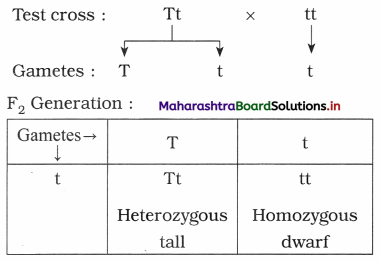
The F2 generation of test cross consists of 50% heterozygous tall plants and 50% homozygous dwarf plants.
(2) Back cross
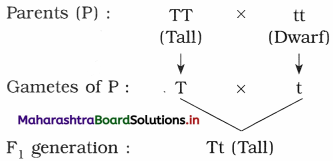
F1 crossed back with its dominant parent
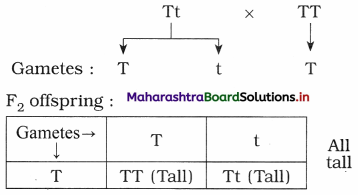
Question 2.
Give a cross for incomplete dominance using a suitable example.
Answer:
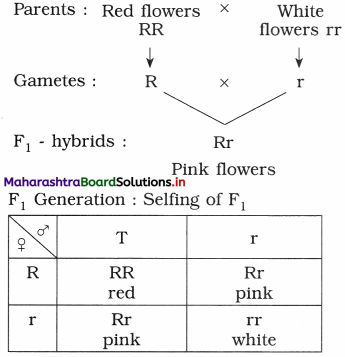
Result:
Genotypic ratio – 1RR : 2 Rr : 11rr
Phenotypic ratio – 1Red : 2 Pink : 1 White
Question 3.
Give a cross of co-dominance using a suitable example.
Answer:
Coat colour in cattle
Red female RR × White male WW
P1 generation : RR × WW
Gametes : R and W
F1 generation all RW Roan coloured
P2 generation RW × RW
| R | W | |
| R | RR | RW |
| W | RW | WW |
Genotypic ratio : 1 RR : 2 RW : 1 WW
Phenotypic ratio : 1 Red : 2 Roan : 1 White
Question 4.
Draw two crosses to show inheritance of colour blindness, (i) A cross between normal female and colour blind male, (ii) A cross of carrier woman with normal man.
Answer:
(i) A cross between normal female and colour-blind male.

(ii) A cross of carrier female with normal male.
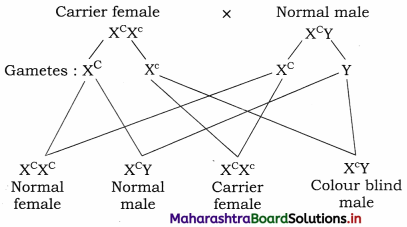
Question 5.
Draw the following crosses to show inheritance of haemophilia : Normal female with haemophilic male. Show their progeny. If one of their carrier daughters marries a normal male what would be possible genotypes of this generation.
Answer:
(1) Haemophilic male crossed with normal female:
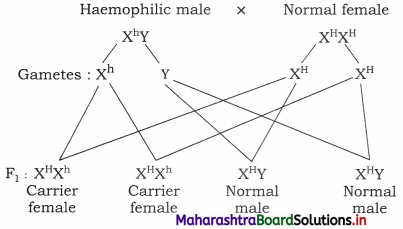
(2) Carrier female crossed with normal male :

![]()
Question 6.
Sketch and label structure of X and Y chromosomes.
Answer:
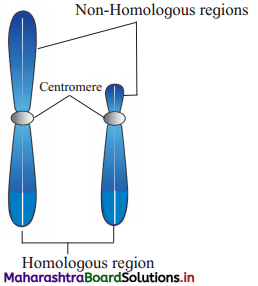
Question 7.
Give the graphical representation of pleiotropy to show inheritance of Sickle-cell anaemia.
Answer:

Long Answer Questions
Question 1.
There are 16 possible individuals in F2 generation. Try to find out the phenotypes as well as the genotypic and phenotypic ratios.
Answer:
In the above dihybrid cross there are 4 phenotypes such as yellow round, yellow wrinkled, green round, green wrinkled.
There are 9 different genotypes as follows:
1 : RRYY / 2 : RRYy / 1 : RRyy / 2 : RrYY / 4 : RrYy / 2 : Rryy / 1 : rrYY /2 : rrYy / 1 : rryy
Question 2.
Explain with suitable diagram how test cross is used to find out genotype of dominant plant.
Answer:
Test cross is used to find out the exact genotype by crossing the F1 individual with homozygous recessive one.
E.g. To find out the genotype of unknown violet flower obtained in F1 generation, one can conduct two crosses as follows:
I. Unknown flower considering as RR (homozygous dominant)
RR × rr Homozygous dominant
| R | R | |
| R | Rr | Rr |
| R | Rr | Rr |
II. In such cross, all the flowers will be violet. II. Unknown flower considering as Rr (heterozygous)
Rr × rr Homozygous recessive with heterozygous
| R | R | |
| R | Rr | Rr |
| R | Rr | Rr |
In such cross half the flowers will be violet and half will be white.
Question 3.
Describe briefly Morgan’s Experiments showing linkage and crossing over. (Diagram is not needed)
Answer:
(1) Morgan used Drosophila melanogaster for his experiments.
(2) He carried out several dihybrid cross experiments to study sex-linked genes of Drosophila.
(3) Crosses between yellow-bodied, white-eyed female and brown-bodied, red-eyed males were done in P1 generation. Brown-bodied and red-eyed forms were wild.
(4) Morgan intercrossed their F1 progeny and noted that two genes did not segregate independently of each other and F2 ratio deviated very significantly from Mendelian 9 : 3 : 3 : 1 ratio.
(5) When genes are grouped on the same chromosome, some genes are strongly linked. They show very few recombinations (1.3%).
(6) When genes are loosely linked, i.e. located away from each other on chromosome, they show more (higher) recombinations (37.2%).
(7) For example, the genes for yellow body and white eye were strongly linked and showed only 1.3 per cent recombination (in cross-I).
(8) White-bodied and miniature wings showed 37.2 per cent recombination (in cross-II). Cross I shows crossing over between genes y and w.
(9) Cross II shows crossing over between genes white (w) and miniature wing (m). Here dominant wild type alleles are represented with (+) sign.
(10) Parental combinations occur more due to linkage and new combinations less due to crossing over.
Question 4.
Describe the mechanism of sex determination in human beings with a suitable cross.
Answer:
1. Sex determination in human beings:
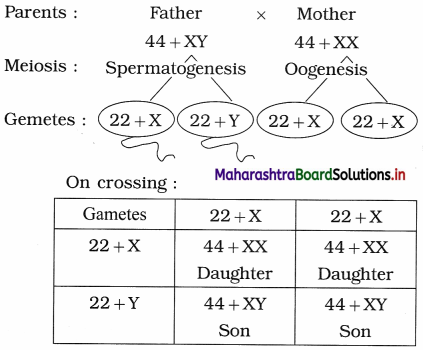
(1) In human beings, the sex is determined with the help of X and Y chromosomes. This chromosomal mechanism of sex determination is of XX-XY type.
(2) In male, the nucleus of each cell contains 46 chromosomes or 23 pairs of chromosomes. Of these 22 pairs are autosomes and one pair of sex chromosomes. Males are thus heteromorphic as they have two different types of sex chromosomes.
(3) Autosomes or somatic chromosomes are responsible for determination of other characters of the body, but not the sex.
(4) In female cells, there are 22 pairs of autosomes and one pair of X chromosomes. Females are thus homomorphic as they have similar sex chromosomes.
(5) Thus the genotypes of female and male are as follows:
Female : 46 chromosomes = 44 autosomes + XX sex chromosomes
Male : 46 chromosomes = 44 autosomes + XY sex chromosomes
(6) During gamete formation, the diploid germ cells in the testes and ovaries undergo meiosis to produce haploid gametes (sperms and eggs). The homologous chromosomes separate and enter into different gametes during this process.
(7) The human male produces two different types of sperms, one containing 22 autosomes and one X chromosome and the other containing 22 autosomes and one Y chromosome. Human males are therefore called heterogametic, i.e. they produce different types of gametes.
(8) The human female produces only one type of eggs containing 22 autosomes and one X chromosome and therefore she is homogametic.
(9) During fertilization, if X containing sperm fertilizes the egg having X chromosome, then a female child with XX chromosomes is conceived.
(10) If Y containing sperm fertilizes the egg having X chromosome then a male child with XY chromosomes is conceived.
(11) The sex of the child thus depends upon the type of sperm fertilizing the egg. The heterogametic parent determines the sex of the child and thus the father is responsible for the determination of the sex of the child and not the mother.
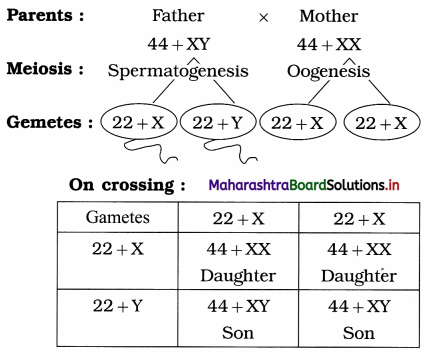
![]()
Question 5.
Explain the mechanism of sex determination in case of birds.
Answer:
- Sex determination in birds is by ZW-ZZ mechanism.
- In birds, males are homogametic while females are heterogametic.
- Males produce all similar types of sperms, containing 8 autosomes and ‘Z’ sex chromosome.
- Females produce two different types of eggs, one containing 8 autosomes and Z chromosome and the other containing 8 autosomes and W chromosome.
- When Z bearing egg is fertilized by a sperm a male offspring is produced. If W bearing egg is fertilized then female offspring is produced.
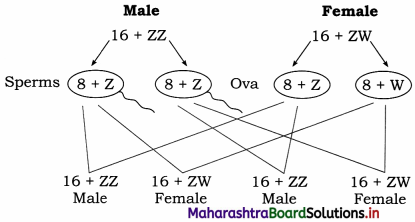
[Note : In domestic fowl chromosome number is 18, with 16 autosomes and two sex chromosomes.]